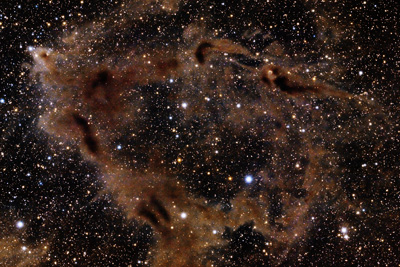rstevenson wrote:You may have retired Ann, but can I ask you to comment on one photo? (And the photographer too can comment, of course.) It's the third one up from this post, Galaxy NGC 3521 by Greg Bradley. On the provided link it says the image is in LRGB.
I have in my desktop collection the image below by Robert Pölzl, from the recent submissions thread of April 5th this year, which is also described as being in LRGB, but as you can see it presents a completely different colour of the galaxy. Any thoughts on these differences?
Rob
NGC3521-LRGB-sm.jpg
Well, Rob, both images are handsome and beautiful. My impression is that Robert Pölzl's image provides a little more detail than Greg Parker's.
However, when it comes to color I think that Greg Bradley's image is a bit "truer".
The B-V index of NGC 3521 is +0.81. That is moderately, though not very, red. It is red enough that we should suspect that this galaxy definitely has a yellow bulge. In Greg Bradley's image the bulge (or inner disk) of NGC 3521 is golden-yellow, almost slightly reddish. In Robert Pölzl's image the bulge is faintly purplish.
A very interesting aspect of NGC 3521 is its diffuse and amorphous but "thick" stellar halo. In my opinion, we should expect a halo population with that kind of "texture" to be yellowish. If it was intrinsically blue, it ought to be slightly clumpy from the presence of clusters.
A stellar halo made mostly of old metal-poor stars will likely be white in color, similar to the integrated color of globulars. But in my opinion, the "thickness" of this halo, which makes it resemble "puffs of smoke", suggests to me that it might not be that old.
It is a known fact that metallicity generally increases as you move closer to the center of a large or moderately large galaxy. If the "thick and smoke-like" halo is comprised at least partly of old metal-rich stars that have been "stirred up" from the bulge, then the color of this halo ought to be yellowish. If I were to guess, Id' say that the color of the "thick" halo of NGC 3521 is likely yellowish. And it looks yellow in Greg Bradley's picture.
However, the very reddish color of the inner bulge of NGC 3521 looks slightly unlikely to me. On the other hand, the inner disk of NGC 3521 definitely contains a good number of emission nebulae, and it is possible that the color balance of the picture has been "weighted" towards the red in order to bring out as many emission nebulae as possible.
In Greg Bradley's image, the bright foreground star differs very markedly in color from the overall color of the galaxy. In Robert Pölzl's image, the color of the star and the color of the galaxy are rather similar. However, it is true that the star is much bluer than the galaxy. The spectral class of the star is F0(V), and its B-V index is +0.42. That is a very normal color for an F-type star. The galaxy, on the other hand, has a B-V index of +0.81. The galaxy is therefore
much redder than the star, and it is to Greg Bradley's credit that he brings out this color difference.
However, the colors of galaxies are subtle. A color index of +0.81 is only very slightly yellower than Capella, whose color index is +0.79. You may want to check out
this image of Capella, which in my opinion does a very good job of showing the true color of Capella. The integrated color of NGC 3521 ought to be similar.
Clearly the bulge (or inner disk) in Greg Bradley's image is
much redder than this. On the other hand: the bulge of NGC 3521 is likely to be redder in color than the color which corresponds to a B-V index of +0.81. The outer disk of NGC 3521 is clearly bluer in the color than the hue which corresponds to a B-V index of +0.81, so in order to arrive at an integrated B-V index of +0.81, the inner disk has to be redder than +0.81 in order to "compensate" for the blue color of the outer disk. For all of that, I don't think that the bulge (or inner disk) is "truly" as red as it looks in Greg Bradley's image, even if we take into account the fact that there are many red emission nebulae in the inner disk of NGC 3521.
Arriving at "true color" is incredibly hard. I thank both Greg Bradley and Robert Pölzl for the fine job they have done portraying galaxy NGC 3521 in RGB!
Ann


